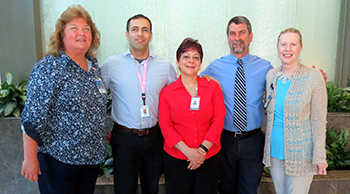
Popular Locations
- Yale New Haven Children's Hospital
- Yale New Haven Hospital - York Street Campus
- Yale New Haven Hospital - Saint Raphael Campus


YNHHS has launched a Health and Safety service line that includes specialists (l-r): Alison Kostopoulos, RN; Brian Rego; Rosa Rodriguez, RN; Bruce Jacobsen and Susan Burke, RN.
Yale New Haven Health System is implementing comprehensive efforts to protect employee safety, by making it easier to report, track, analyze and help prevent injuries and workplace violence.
“Yale New Haven Health’s quest – our responsibility – is to provide the safest workplace, not only for our patients and visitors, but also for employees,” said Jodie Boldrighini, RN, executive director, YNHHS Occupational and Employee Population Health Solutions.
She is overseeing employee safety efforts, along with Stephen Jones, MD, Yale New Have Health System medical director of Safety, and Mark Sevilla, RN, Yale New Haven Hospital vice president, Patient Services, Behavioral Health and Emergency Medicine.
YNHHS launched injury-prevention efforts last year with a new Employee Safety service line that includes a health and safety manager and specialists at each delivery network. The specialists’ roles include analyzing data to identify the most common types and causes of employee injuries, and working with department leaders to develop action plans to prevent future injuries.
The specialists get the data from a YNHHS employee-injury reporting system that also launched last year. The system is separate from, but similar to, the RL Solutions system used to report patient safety events.
In addition to standardizing the reporting process throughout YNHHS, the system generates a report so managers can view injuries by type, cause and location, among other criteria.
“With the reporting, managers will be able to see events and trends in their departments in real time, which will help them target improvement efforts,” Dr. Jones said.
Data collected so far show that the most common injury types are slips, trips and falls; strains and sprains; exposure to blood-borne pathogens; and injuries resulting from aggressive behavior.
Boldrighini and Sevilla co-chair a YNHHS task force that is analyzing and developing creative ways to reduce aggressive behavior toward employees. The group is focusing on four areas: training and education, documentation and reporting, assessment of patients for violent behavior, and communication. The task force is also exploring post-event care for employees, including counseling and other programs available through Employee and Family Resources.
The task force comprises employees and leaders from different YNHHS organizations, departments and clinical and non-clinical disciplines. Anyone interested in participating may contact Boldrighini at [email protected].
Efforts to reduce employee injuries and aggressive behavior are part of a larger YNHHS project to improve not only patient and employee safety, but also the safety of facilities and environments of care and cyber-security. A YNHHS safety council launched in the past six months has begun working on the project.
“This group is looking at how all of these elements intersect,” Sevilla said. “Our hope is that by using existing best practices and coming up with our own innovative solutions, we can create a global safety strategy that will protect everyone we care for, employ and do business with.”
To report an injury employees can: